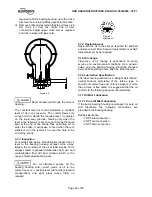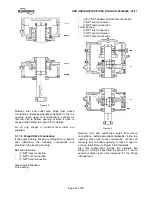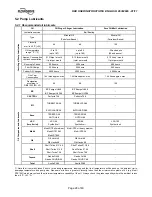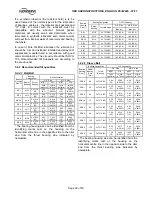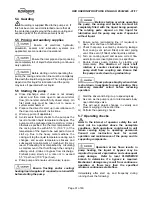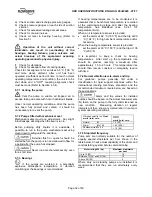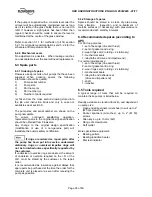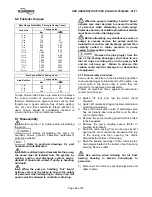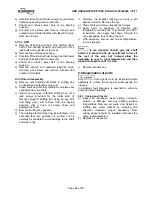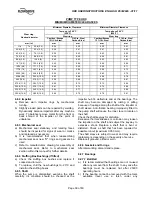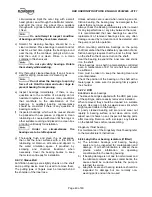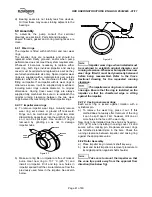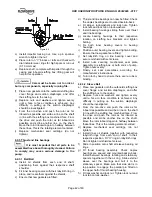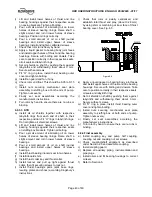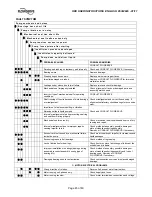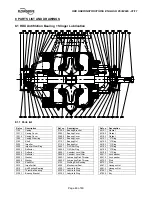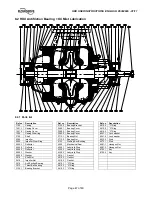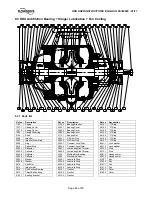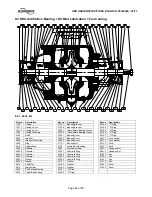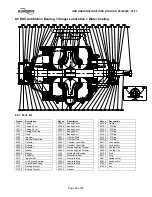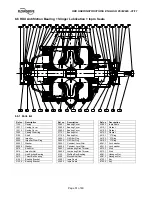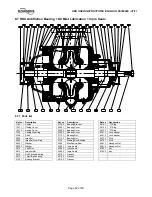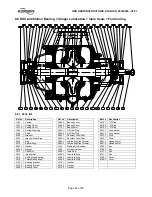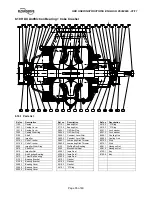
HDX USER INSTRUCTIONS ENGLISH 85392696 - 01/11
Page 40 of 60
circumstances. Split the outer ring with a small
hand grinder, saw through the ball/roller retainer,
and split the inner ring about three quarters
through with a grinder and break with a cold steel
chisel.
Do not attempt to inspect condition
of bearings until they have been cleaned.
c) Solvent for cleaning bearings should be in a
clean container. Place bearings in solvent and let
soak for a short time. Agitate the bearing around
near the top of the container, giving it a turn now
and then until it is clean. Rinse in a clean
container of fresh solvent.
Do not spin dirty bearings. Rotate
them slowly while washing.
d) Dry thoroughly cleaned bearings. If an air hose is
used for drying, make sure it is clean dry air.
Do not allow the bearings to spin by
force of air. Hold the inner and outer rings to
prevent bearing from spinning.
e) Inspect bearings immediately. If there is any
question as to the condition of a bearing do not
hesitate to replace it. There are many conditions
that contribute to the deterioration of the
bearings. A qualified bearing representative
should be consulted if there is any question of
bearing condition.
f) Inspected bearings which will be reused should
be packed with new grease or dipped in clean
lubricating oil, covered with clean lint free rags or
other suitable covering and placed in a clean box
or carton until ready for installation.
Under no circumstances the
bearings are to be left exposed.
g) Thoroughly flush and clean the oil passages,
then coat the inner surfaces with a thin film of
lubricating oil. Remove all scale and deposit in
the water circulation space, if provided, by
scraping and chemical treatment when
necessary. Cover the bearing bodies to keep
them clean until ready for installation
6.8.7.2 Sleeve Ball
Anti-friction bearings are slightly shrunk on the shaft
and a pulling device must be used to remove them.
The pulling jaws or fingers must be located behind
the shoulder of the inner race.
Unless extreme care is used when removing an anti-
friction bearing, the bearing may be damaged to the
extent that is no longer useable.
Always check the bearing immediately after removal
for any imperfections or any play between the races.
It is recommended that new bearings be used for
replacement of removed bearings since very often
damage caused by removal cannot be detected until
the pump is put into operation.
When mounting anti-friction bearings on the pump
shaft remember that the satisfactory operation of anti-
friction bearings requires that the inner be firmly held
on the shaft so that it cannot turn on the shaft.
Heat the bearing to expand the inner race and shrink
it on the shaft.
Place bearings on a shelf in a temperature controlled
oven. A temperature of 80° for one half hour should
be sufficient.
Care must be taken to keep the bearing clean and
uncontaminated.
Check the position of the bearing on the shaft with a
feeler gage to make sure it is pressing firmly against
the shoulder.
6.8.7.3 KTB
Babbitted sleeve bearings
The sleeve bearings supplied with the HDX pump are
of the split type and are easily removed or installed.
When removed, they should be cleaned in a suitable
solvent. Use rags or cloth, as waste leaves lint which
might cause trouble in the bearing.
A poorly cleaned bearing will score and wear out
rapidly. A bearing surface is not clean until a cloth
wiped over it shows no soil. Inspect all bearing parts
after cleaning. Remove, with a scraper, any bruises
on the babbitt faces before reassembling.
Kingsbury thrust bearing
For maintenance of the Kingsbury thrust bearing refer
to the manufacturer’s instructions.
6.8.8 Labyrinths or bearing isolators (if fitted)
a) The lubricant, bearings and bearing housing
seals are to be inspected for contamination and
damage. If oil bath lubrication is utilized, these
provide useful information on operating
conditions within the bearing housing.
b) If bearing damage is not due to normal wear and
the lubricant contains adverse contaminants, the
cause should be corrected before the pump is
returned to service.
c) Labyrinth seals and bearing isolators should be
inspected for damage but are normally non-
wearing parts and can be re-used.

